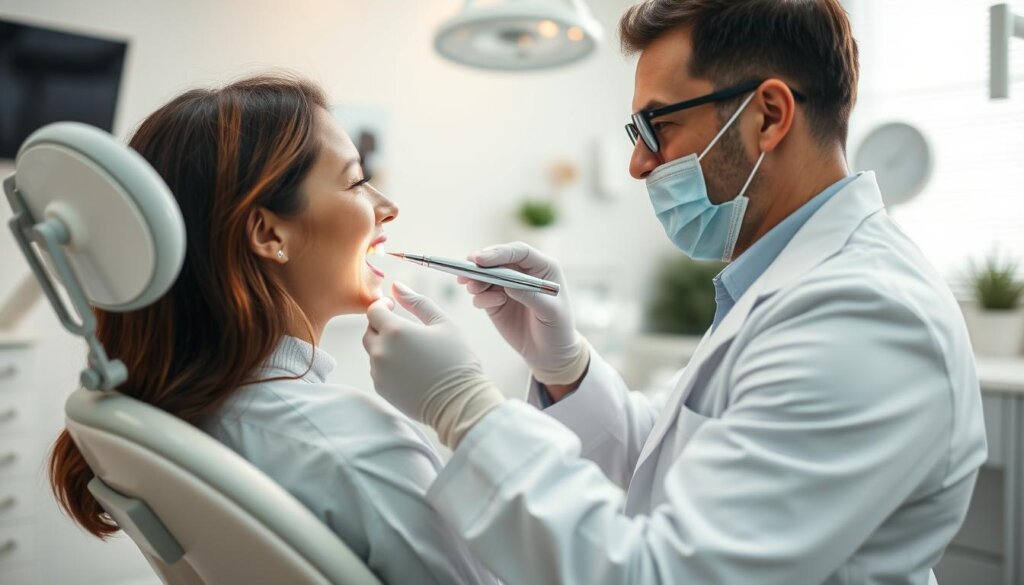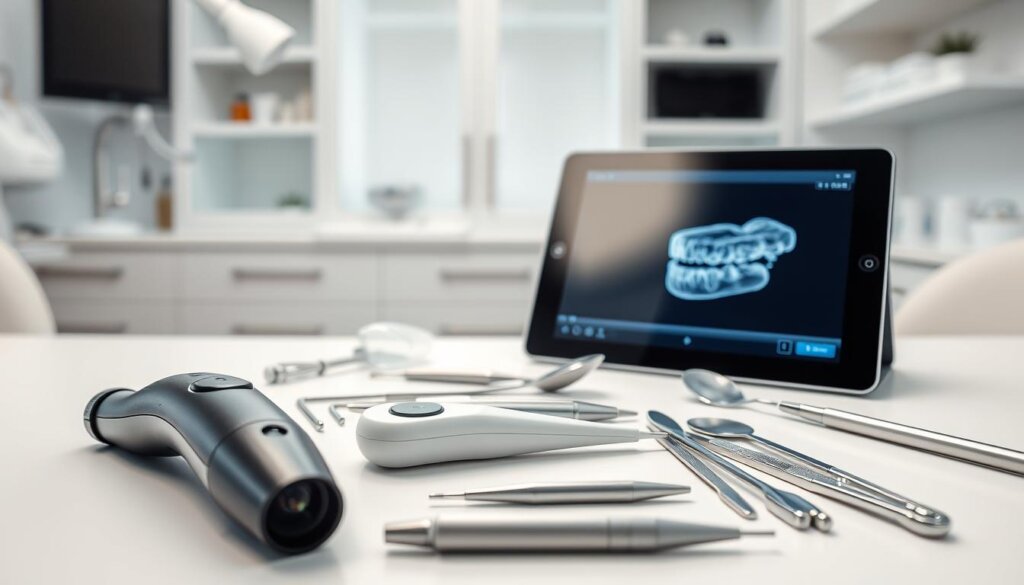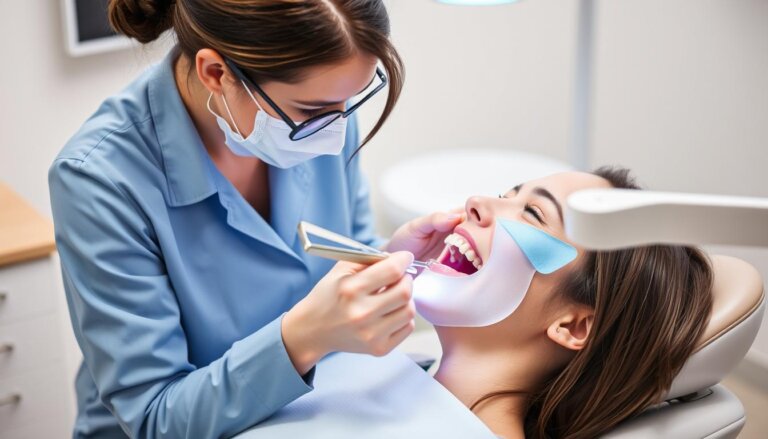Can I Refuse X-rays and Still Get My Teeth Cleaned?
Every year, millions of dental x-rays are done across the United States. They give a clear view of what’s happening under our smiles. But, more and more people are asking if they can skip the X-rays but still have their teeth cleaned. This question is common among patients today. They avoid X-rays for reasons like fear of radiation or the cost. This resistance is making dentists think hard about patient rights, the need for X-rays, and their own professional guidelines.
The American Dental Association (ADA) and the U.S. Food and Drug Administration (FDA) suggest using X-rays wisely, based on each patient’s needs. But, dentists face a tough situation when patients want a cleaning without X-rays. They must balance respecting the patient’s wishes with their own professional responsibilities. Making the right choice requires understanding the risks of skipping X-rays during teeth cleaning.
Key Takeaways
- The rising trend of X-ray refusal for teeth cleaning exemplifies a shifting landscape in patient-clinician dynamics.
- Dental professionals are challenged to maintain the standard of care while honoring the principle of informed consent.
- The ADA and FDA have set forth recommendations underscoring a need for a tailored approach to dental radiography.
- Understanding the implications and alternatives to dental cleaning without X-rays is imperative for both clinicians and patients.
- Navigating patient autonomy and clinician responsibility requires astute balance and clear communication.
- Addressing X-ray refusal for teeth cleaning involves developing protocols that respect patient choices without compromising oral health.
Understanding the Role of X-rays in Dentistry
The world of dental care often emphasizes the importance of X-rays. But, as people become more health-conscious, they look for alternatives to dental X-rays to keep their dental hygiene without X-rays. We’ll explore how dental X-rays are essential for oral health, and how we can mix old methods with new worries.
Dental X-rays give a detailed view of what’s hidden in our mouths. They can find various issues like unseen structures, masses, bone loss, and hidden cavities.
What Are Dental X-rays?
Dental X-rays are tools that show what we can’t see in a normal check-up. They let dentists look at teeth, roots, how our jaws are set, and the structure of our face bones. These images help spot and fix dental issues early, saving us time, money, and discomfort.
Why Are X-rays Important for Oral Health?
X-rays give a deep look into our dental health and any hidden problems. They’re key for diagnosing and planning treatment for issues like impacted teeth, abscesses, and jawbone damage. Thanks to X-rays, dentists can fully assess oral health and prevent future troubles.
Yet, with newer dental tech and a push for less invasive care, both dentists and patients are looking at alternatives to dental X-rays. These new options help keep our mouths healthy without X-rays. They make sure people worried about radiation have other choices.
The Dental Cleaning Process Explained
Understanding how dental cleanings work is key. This includes learning about options like no X-ray dental cleaning. Dental cleanings help keep your mouth healthy and prevent future problems.
Dental X-rays used to be a must for finding hidden decay and checking bone levels. But now, some prefer not to use X-rays.
- Initial Examination: A visual check-up looks at the health of your teeth and gums. This starts the X-ray-free teeth cleaning.
- Plaque and Tartar Removal: Dental experts carefully get rid of plaque and tartar. This step doesn’t need X-rays first.
- Polishing: After removing tartar, your teeth get polished. This makes them look better and feel smoother.
- Flossing and Rinsing: Flossing cleans between your teeth. A fluoride rinse makes your teeth stronger. This finishes the no X-ray cleaning.
Choosing X-ray-free cleaning is for those worried about X-ray exposure. It’s less invasive but still keeps teeth healthy. Without X-rays, dentists still do a thorough check-up and cleaning.
Legal Rights Regarding Dental Procedures
In the US, dental patients have strong rights about their treatments. This includes choosing to opt out of dental X-rays. Informed consent is key to these rights. It’s a must in healthcare.
This approach lets patients make smart choices about their dental care. They understand the risks and benefits. For example, they learn what happens if they skip X-rays during a dental cleaning without X-rays.
Informed consent is not merely a signed document; it’s a process of communication between a healthcare provider and their patient that results in the patient’s authorization or agreement to undergo a specific medical intervention.
Here are some main patient rights in dentistry:
- Right to Informed Consent: Dentists must explain procedures clearly, including risks of not getting dental X-rays.
- Right to Privacy and Confidentiality: Patient health info must be kept secret.
- Right to Refuse Treatment: Patients can say no to treatment, even against their dentist’s advice.
This rights framework supports patient choice and ethical dentistry. Yet, it brings up challenges. For example, it’s tough for dentists when patients opt out of dental X-rays. Such X-rays help find hidden problems that might affect treatment outcomes.
In the end, patients can choose to avoid some procedures. But these choices must come from understanding the risks. This ensures everyone follows legal standards and keeps care quality high.
Communicating with Your Dentist
Talking openly with your dentist is important, especially about worries over traditional dental X-rays. Patients often worry about the costs, possible discomfort, and the fear of getting exposed to radiation. It’s crucial for patients to talk about these worries to explore alternatives to dental X-rays for safe dental hygiene without X-rays.
It is our right as patients to discuss and explore less invasive options without comprising the quality of our dental care.
When you have concerns about X-rays, come prepared with specific questions and alternatives. Being proactive helps make talks with your dentist more useful. This way, you’ll find solutions that both of you agree on, keeping comfort and safety in mind.
- Express your concerns clearly regarding the use of traditional X-rays.
- Ask about the latest advancements in alternatives to dental X-rays that might be available at the clinic.
- Discuss the feasibility of dental hygiene without X-rays and what diagnostic alternatives can be provided.
Nowadays, many dental places have ways to lessen or skip traditional X-rays while still getting the needed diagnostic info. For example, some clinics use digital imaging that lowers radiation and makes clearer images. This helps with better diagnosis and treatment plans.
The main aim in discussing alternatives to dental X-rays is to keep patients comfortable and still keep dental health checks top-notch. By using new technology or different diagnostic methods, getting great dental hygiene without X-rays is possible. Working together and talking clearly with your dentist is essential in finding these options.
Potential Risks of Refusing X-rays
Not getting dental X-rays can seriously harm your oral health. Some might want to avoid X-rays with teeth cleaning. But knowing the risks is vital. This section talks about the problems and complications that can happen if X-rays are skipped.
Wondering if you can skip X-rays and get your teeth cleaned? It’s key to know X-rays are crucial. They find dental problems not seen with just a look. Without X-rays, you might miss serious oral health issues.
Undetected Dental Issues
- Hidden decay: X-rays can spot early decay between teeth, under fillings, or where it’s hard to see.
- Internal abnormalities: For detecting cysts, tumors, or bone issues, X-rays are needed.
- Gum disease: X-rays are also important to check the bone level around teeth, showing damage from periodontitis not visible otherwise.
Possible Complications During Cleaning
Skipping X-rays can affect disease detection and the cleaning process. Here’s what might happen:
- Tartar might not be fully removed from hidden areas, leading to gum disease.
- Teeth that are weak could get damaged during cleaning if not spotted by an X-ray.
- Infections that are missed could cause pain or serious problems after cleaning.
In short, think carefully before deciding to skip dental X-rays for cleaning. Talk with your dentist about your worries and choices. This helps avoid harm to your oral health.
When Are X-rays Necessary?
Knowing when to use X-rays for dental care is key for good oral health. Some people might look into X-ray alternatives for dental hygiene, but it’s key to know when X-rays are needed. They are crucial not just for regular check-ups to monitor oral health progress, but also to spot specific issues that can’t be seen during a regular exam.
X-rays are essential to find hidden issues that could be missed without them. When deciding to use X-rays, dentists think about the patient’s past dental history, current symptoms, and the risk of future dental problems.
Routine Check-Ups vs. Specific Concerns
During regular dental visits, X-rays are important to check the health of teeth and jawbones that we can’t see. They help spot early signs of decay, bone loss, or other issues that might need action. Meanwhile, if someone comes in with certain symptoms or after an accident, X-rays are needed to find the cause of the problem and plan how to fix it.
Frequency Recommendations for X-rays
Dental professional groups suggest how often to get X-rays based on factors like age, oral health, and dental disease history. For example, people who get cavities often or have gum disease might need X-rays more to watch their condition closely. But those with few dental problems and who take great care of their teeth might not need X-rays as much.
Using dental X-rays wisely, including knowing when skipping them is okay, helps give care that fits each person’s needs and preferences. This means finding the right balance between preventing health issues and limiting X-ray use. Patients and dentists should work together to decide what’s best for each individual.
Alternatives to Traditional X-rays
In the world of dentistry, there’s a big push for X-ray alternatives for dental hygiene. This push is because people are looking for X-ray-free teeth cleaning. Traditional X-rays work well but have some downsides like radiation exposure. This has led to the creation of new tools for checking teeth.
Digital X-rays are leading the charge in alternatives. They cut down a lot on radiation, making them safer for both patients and doctors. Their better picture quality also means doctors can see issues more clearly. This is crucial for all sorts of dental work.
But it’s not just about digital X-rays. There are more ways to check teeth without X-rays, such as:
- Intraoral cameras give live pictures of the inside of your mouth, helping spot problems without X-rays.
- Diagnostic lasers find cavities and other issues accurately, with less discomfort.
- Ultrasound technology is still being tested for teeth but could help see soft tissues and problems without being invasive.
Although these new tools are helpful, they don’t fully replace X-rays. They each have their strengths and can be used together. This way, X-rays are less needed but doctors can still diagnose properly.
The push for digital in dentistry is making care safer, faster, and more accurate for everyone. As tech gets better, we might see even more impressive ways to care for our teeth without X-rays in the future.
What to Expect During Your Cleaning
Choosing a dental cleaning without X-rays leads patients down a unique path. This method puts comfort and safety first. It also follows a wish to limit radiation exposure.
Initial Assessment Without X-rays
First, the dentist checks your mouth without X-rays. They look for signs of gum disease or cavities and learn about your dental care habits. This approach does not let them see inside the teeth or under the gums like X-rays do.
The Hygiene Process
Cleaning teeth without X-rays focuses on getting rid of plaque and tartar. Afterward, each tooth is polished to make it smooth and shiny. Teaching you the best ways to look after your teeth is also crucial.
Here’s how dental cleanings differ with or without X-rays:
| Procedure | With X-rays | Without X-rays |
|---|---|---|
| Initial Assessment | Detailed imaging of tooth and bone structure | Visual examination and history review |
| Plaque and Tartar Removal | Guided by detailed imagery | Focused on visible areas |
| Polishing and Fluoride Treatment | Applied uniformly | Applied based on visible assessment |
| Educational Guidance | Customized based on full oral assessment | General advice on oral hygiene |
Even though dental cleaning without X-rays and dental hygiene without X-rays have their limits, they’re good choices for those wary of radiation. They focus a lot on what can be seen and teaching patients how to keep their teeth healthy.
The Impact of Refusing X-rays on Treatment
Choosing dental hygiene without X-rays changes the care you get. X-rays help spot problems that can’t be seen just by looking. So, if you wonder can I refuse X-rays and still get my teeth cleaned?, your treatment might change.
Delays in Diagnosis and Treatment
Without X-rays, dentists can miss early decay or bone loss. This means they might not catch issues until they’re big enough to see during a check-up. So, problems could be found later than they could have been.
Adjustments in Cleaning Protocols
Dentists might clean your teeth differently without X-ray details. They take a gentler approach to avoid harming areas they can’t see. This might mean your teeth don’t get as clean, or you might need more visits.
Here’s a table that shows how treatments change without X-rays:
| Treatment Aspect | With X-Rays | Without X-Rays |
|---|---|---|
| Approach to Cleaning | Targeted based on detected issues | Generalized and conservative |
| Frequency of Visits | As needed based on clear diagnoses | Potentially more frequent to monitor changes |
| Diagnosis of Hidden Conditions | Early detection and intervention | Late detection, potentially evolving into complex cases |
Talking to your dentist about dental hygiene without X-rays is important. Discussing refusing X-rays and still getting your teeth cleaned helps set the right expectations. This way, you get the best care, adjusted for your X-ray choice.
Financial Implications of X-ray Refusal
Deciding to skip dental X-rays affects your oral health and wallet. It’s key to understand the money side, including how it works with insurance and the cost of other options. Before saying no to X-rays, think about what it means for your pocket.
Insurance Policies and Coverage
Many dental insurances cover X-rays during checkups, but how often varies. Knowing what your insurance offers helps plan your visits. Most find their plan covers preventive care well but may not cover other options as much.
Costs of Alternative Assessments
Looking at other options besides X-rays can cost more. Some methods use less radiation but hit your wallet harder. Deciding what’s best involves balancing health worries and your budget. Below are common options and their costs to help you decide.
| Alternative Method | Typical Cost | Frequency Needed |
|---|---|---|
| Digital X-rays | $70 – $150 | Every 1-2 years |
| Intraoral Camera | $40 – $60 | Each visit |
| Thermal Imaging | $200 – $300 | As needed |
Think about both now and the future when deciding on X-rays. You might save now but miss issues that cost more later.
Educating Yourself About Dental Health
Learning about dental health is key, especially for those who prefer X-ray-free teeth cleaning. It also matters for those wanting to keep their teeth clean without X-rays. Reliable sources help patients learn about other ways to take care of their teeth.
Many people look for information on avoiding dental X-rays. They find helpful studies and safety tips in trustworthy books and websites. Talking to dentists who understand the need for X-ray-free teeth cleaning is another way to learn.
When you choose dental hygiene without X-rays, remember the importance of regular check-ups. These visits are Vital. They help catch and manage tooth problems early, using methods other than X-rays.
| Resource Type | Description | Benefits |
|---|---|---|
| Peer-reviewed Literature | Research articles evaluating non-X-ray dental practices | Provides scientifically backed information on the effectiveness of alternatives |
| Professional Dental Associations | Guidelines and statements on X-ray alternatives | Offers professional standards and safety measures for X-ray-free procedures |
| Consultations with Dentists | Personalized discussions on dental hygiene practices without X-rays | Facilitates tailored dental care plans respecting patient’s preferences |
Knowing more helps you make better choices for your dental care. It also keeps the conversation going with your dentist. This ensures your dental care matches what you value most about your health.
The Role of Technology in Modern Dentistry
Dentistry is always getting better with new tech. Now, digital X-rays are changing the game. They make diagnosing more accurate and expose patients to less radiation. Technology doesn’t just upgrade tools; it makes dental care safer and better every day.
Advancements in dental imaging are a big deal for dentists. They help to spot problems more accurately and plan better treatments. Digital X-rays show clearer images right away. This helps dentists be quick in checking patients and giving them updates.
Looking ahead, dental imaging is getting even better. Scientists are working on ways to lower radiation and make images clearer. Stuff like 3D imaging and digital scans give a fuller picture of dental health. They can catch problems early, problems that old X-rays might miss. These new tools are all about less invasive care and making patients more comfortable.
Dental pros need to keep up with these tech updates. Using new tools improves care and helps keep everyone healthy. Staying ahead with technology helps the dental world meet today’s and tomorrow’s needs.
Building a Relationship with Your Dentist
The success of dental care relies not only on the dentist’s skills but also on trust and communication. Finding a dentist who honors your wishes for a dental cleaning without X-rays is key.
- Look for dentists open to methods like non-X-ray diagnostics.
- Check out reviews to see how other patients view their trust and flexibility with the dentist.
- Have a chat to share your needs and concerns directly with the dentist.
Talking openly about wanting a dental cleaning without X-rays helps build a strong understanding and trust. A relationship based on mutual respect and trust not only improves your oral health but makes you feel safe and confident in your dental care choices.
Preparing for Your Dental Visit
Going to the dentist is very important for keeping your mouth healthy. To get the most from every visit, it helps to be ready. This means knowing the best questions to ask your dentist. Good talk between you and your dentist makes sure your treatment is what you expect and need.
Before your appointment, make a list of questions to ask your dentist. This will help clear up any confusion about treatments or your overall dental health. It’s also smart to tell your dentist how you feel about different treatments. This is especially true if you’re nervous about things like X-rays.
- What are the necessary steps for preparing for a dental visit?
- What should I expect in terms of initial examination and diagnosis?
- Can you explain the benefits and risks associated with the recommended treatment?
- Are there any alternative treatments, and how do they compare?
- What are the estimated costs, and what financial options are available?
It’s a good idea to share any personal likes or dislikes you have with your dentist. This could be about the kind of anesthesia, preventive care, or how dental treatments look. Making sure your dentist knows your preferences is key to a good dental visit.
| Category | Questions | Your Preferences |
|---|---|---|
| Procedures | What procedures will be performed, and why? | State any preferences for sedation or pain management |
| Risks | What are the potential risks of this treatment? | Discuss any anxieties or past experiences |
| Recovery | What is the expected recovery time and aftercare? | Express any concerns regarding recovery period or follow-up treatments |
Being well-prepared and able to communicate are key to a great dental visit. By preparing for a dental visit with the right questions to ask your dentist, you help make sure your oral health care is tailored to you.
Final Thoughts on X-ray Refusal and Dental Care
Choosing not to get X-rays at dentist visits is serious. If you’re thinking about not having X-rays for teeth cleaning, carefully think about the good and bad sides. Making smart choices in dental care means knowing all about how helpful, but also the limits, of not using this tool.
Weighing the Pros and Cons
Modern digital images have made dentistry much better, spotting problems early. But, worries about radiation or money might make someone skip X-rays. It’s important to think about your concerns but also the risk of missing signs of tooth decay or other issues.
Making Informed Choices for Your Health
Choosing wisely means knowing how X-rays help find big dental problems early and what happens if they’re not used. Talk openly with your dentist, look at the science, and think about what’s best for you. In the end, it’s about working with your dentist to get the best care for you.






